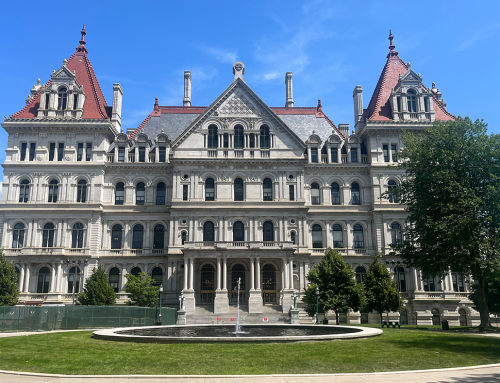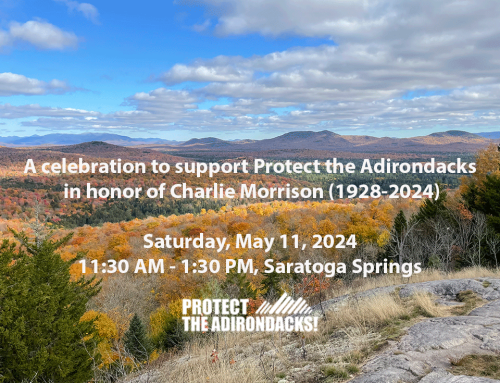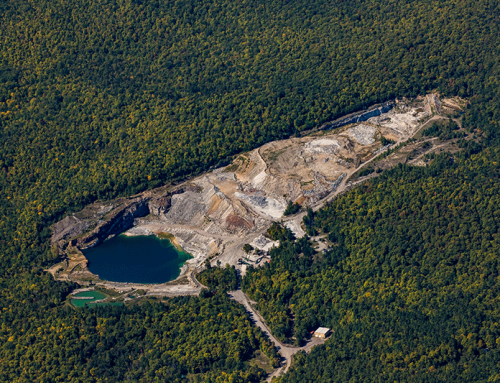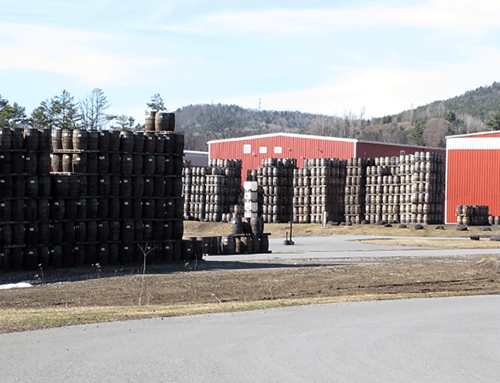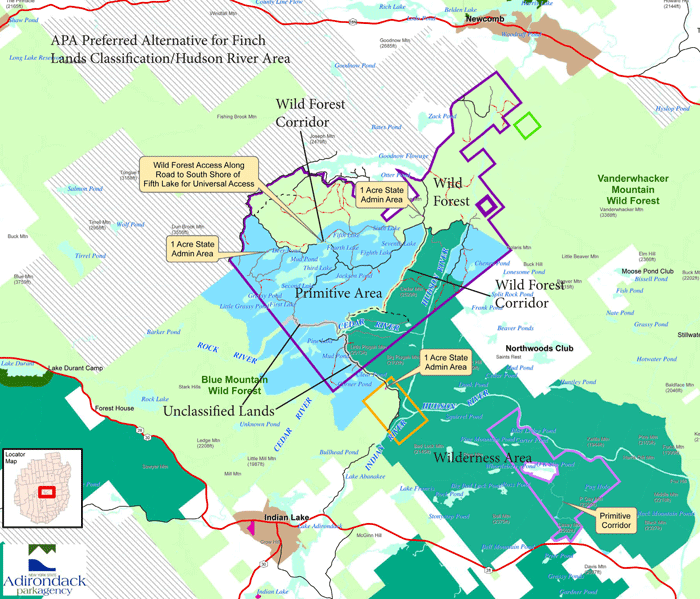
The APA proposes a new 21,573-acre Wilderness Area for the Hudson Gorge and a mix of Primitive and Wild Forest areas as well as unclassified corridors and a large Wild Forest corridor for the former Finch lands.
For a PDF copy of PROTECT’s letter click here.
December 11, 2013
Lani Ulrich, Chair
NYS Adirondack Park Agency
PO Box 99
Ray Brook, NY 12977
RE: Public Comments on the 2013 Forest Preserve Classifications Package
Dear Chairwoman Ulrich,
Protect the Adirondacks has reviewed the staff Preferred Alternative and various materials publicly released by the Adirondack Park Agency (APA) pertaining to the 2013 classification package of newly purchased and existing Forest Preserve lands. PROTECT finds many things to cheer in the APA’s Preferred Alternative. Unfortunately, PROTECT also finds things that are deeply troubling and some that violate the law.
PROTECT finds much to celebrate in the APA’s Preferred Alternative, including the creation of a new Wilderness area, designation of a universal access site, and management of the Essex Chain Lakes as a “motorless” area. PROTECT’s enthusiasm for the entire Preferred Alternative is tempered by additional actions that would create extensive Wild Forest corridors, the decision to retain the Polaris Bridge over the Hudson River, the construction of a new bridge over the Cedar River, and changes in the way that Primitive areas are designated and managed. Additionally, PROTECT found the administrative process for the public Forest Preserve classification to be needlessly shrouded in secrecy and at variance with existing laws, policies, and regulations.
PROTECT supported Wilderness Alternative 1A during the APA public hearings, and no matter how it is that public comments are analyzed and organized, the fact remains that the vast majority of comments supported a new large Wilderness area for the Essex Chain Lakes and Hudson River. Moreover, we believe that the sensitive natural resources that are abundant in the Hudson River corridor and gorge, the Cedar River corridor, and throughout the Essex Chain tract, all require a level of protection best provided through a Wilderness classification.
PROTECT recognizes that the APA’s Preferred Alternative for a Wilderness classification for the 23,572-acre Hudson River Gorge area and extensive use of Primitive classifications for other sensitive areas will provide strong natural resource protection. Nevertheless, PROTECT believes that a historic opportunity is being missed in the APA’s Preferred Alternative – due to the motorized Wild Forest corridor through the heart of the area – to create a major new Wilderness area that protects a vast landscape and would enable a truly wild and remote core to be restored over the ensuing decades.
PROTECT Applauds New Hudson River Gorge Wilderness Area: PROTECT commends the APA for recommending the creation of a new Wilderness Area for the Hudson Gorge. This new 23,572-acre Wilderness area would be the largest single Wilderness area created since the adoption of the original State Land Master Plan. However, PROTECT notes that this is not the largest Wilderness classification. In 2000, the APA classified over 44,000 acres to create the William C. Whitney Wilderness area and expanded the Five Ponds and Pepperbox Wilderness areas. It should be pointed out that classification of Wilderness is a relatively rare feat and that there remains over 100,000 acres more of Wild Forest lands in the Forest Preserve than Canoe, Primitive and Wilderness areas combined.
PROTECT Applauds Inclusion of a Universal Access Site: PROTECT also recognizes the efforts by the APA and the Department of Environmental Conservation (DEC) to create a universal access site in the Essex Chain Lakes area. PROTECT has supported this concept from the beginning.
PROTECT Applauds Motorless Management of Essex Chain Lakes: PROTECT also commends the APA and DEC for recommending “motorless” management for the Essex Chain Lakes. However, PROTECT does not believe that a Primitive classification is the right choice, unless it’s a temporary classification until all the reserved leaseholder rights are extinguished. PROTECT believes that a Wilderness classification for the Essex Chain Lakes and Cedar River areas is the best classification choice.
Classification Process Marred by Irregularities: PROTECT finds that the classification process was marred by a variety of procedural gaffes by APA. While we acknowledge that there are widely differing and competing visions for the future of the Adirondack Park, we believe that this Forest Preserve classification process could have been handled much better. PROTECT finds five major failings with the process to date:
1. The decision by the APA leadership to withhold the “Booth Memo” serves no reasonable purpose. APA rejected a Freedom of Information Law request from PROTECT and has so far failed to respond to our appeal of this denial. The Booth Memo contains the ideas of the Chairman of the State Lands Committee about this classification. This memo should be publicly disclosed. We call upon the APA Board members to see to it at the December meeting that the Booth Memo is released and posted to the APA website immediately (and copies provided at the APA meeting).
2. The major document dump at the end of the process and various legal filings preclude a decision by the APA until December 23, 2013 at the earliest. APA’s plan (according to the December APA Meeting agenda) to vote on December 13th, openly violates the State Environmental Quality Review Act (SEQRA) regulations. PROTECT offers more detailed comments on SEQRA issues below.
3. The failure to complete and provide information that was requested by APA Board members at earlier meetings in August and September is troubling. In August, a list of more than three dozen issues was prepared during the meeting whereby APA Board members sought additional information on a range of issues, but this request was only partially fulfilled. Similarly, a request in September for a legal/policy memo about issues involved in classification options of Wild Forest, up to Wilderness, was requested, but never supplied. These documents would have been useful to APA Board members as they prepare to make a historic decision and also would have aided in the education of the public.
4. In August, Board members asked the APA leadership that the process be managed so that there was adequate time to review all materials prior to a vote. The situation that some APA Board members sought to avoid is now occurring with a massive document dump and expedited vote. It appears the APA leadership is racing to meet a year-end deadline that was imposed by the Executive Chamber, but not required by any statute, policy or regulation.
5. Materials were slow to be released to the public by the APA this month, which limited the effectiveness of public review. The FSEIS, appendices, and maps were not released until the afternoon of Friday, December 6th. APA mailing packages are generally posted on Thursdays prior to an APA meeting. The “Draft Resolution” with respect to the 2013 classification package was not posted until Tuesday, December 10th at 4 PM, which is a marked delay, and less than 24 hours from when the APA Board will begin its deliberations.
The process administered by the APA could have been more open and transparent and generous in sharing of important information with the public and timely in its preparation and release of important documents. We suspect that in the limited time that we have had to review these materials we have only scratched the surface of the important issues that should be brought to your attention before the APA votes on this decision. PROTECT requests that APA delay any action on this decision until the January 2014 meeting, as required by SEQRA.
PROTECT has reviewed the APA staff’s Preferred Alternative in the FSEIS and offers the following initial comments.
Natural Resource Protection Should be the Dominant Consideration During Classification, not Recreational Use: The APA Act requires the APA to classify Forest Preserve lands according to “their characteristics and capacity to withstand use.” The State Land Master Plan (SLMP) classifies all Forest Preserve lands according to their physical characteristics (soil, slope, elevation and water), biological characteristics (boreal, subalpine and alpine zones, wetland ecosystems, wildlife habitats), certain intangible considerations (such as sense of remoteness, degree of wildness, scenic quality, ruggedness), the suitability of certain areas for specific uses and finally established facilities on the land. The SLMP states in its opening sections the importance of natural resource protections:
“If there is a unifying theme to the classification system, it is that the protection and preservation of the natural resources of the State lands within the Park should be paramount. Human use and enjoyment of those lands should be permitted and encouraged, so long as the resources in their physical and biological context and their psychological aspects are not degraded.”
The 1979 Final Programmatic Environmental Impact Statement for state land classifications shows a clear preference for Wilderness classifications given their rareness across New York and beyond. “Wilderness recreational opportunities are scarce in New York and rare in the northeastern United States. Adirondack wilderness constitutes only 3% of New York State, and 91% of all designated wilderness in the Northeastern United States. Intensive recreational opportunities are relatively abundant throughout the State and are provided by both the public and private sector which often compete.”
SEQRA Requires a Public Review Period Until December 23, 2013: Page 2 of the APA’s Final Supplemental Environmental Impact Statement (FSEIS) states that the date of acceptance by the Lead Agency (APA) is December 13, 2013. Hence, the public has ten days to comment from the date of acceptance, until December 23, 2013. Please note that this letter constitutes initial public comments by PROTECT. As of Tuesday afternoon at 4 PM, December 10, 2013, the APA had just posted additional important information on its website. Please note that PROTECT will provide more substantive comments by the December 23, 2013 deadline under SEQRA.
The relevant SEQRA regulations are in 6 NYCRR § 617.11 “Decision-making and findings requirements” which states, with the pertinent portions highlighted:
(a) Prior to the lead agency’s decision on an action that has been the subject of a final EIS, it shall afford agencies and the public a reasonable time period (not less than 10 calendar days) in which to consider the final EIS before issuing its written findings statement. If a project modification or change of circumstance related to the project requires a lead or involved agency to substantively modify its decision, findings may be amended and filed in accordance with subdivision 617.12(b) of this Part.
(b) In the case of an action involving an applicant, the lead agency’s filing of a written findings statement and decision on whether or not to fund or approve an action must be made within 30 calendar days after the filing of the final EIS.
(c) No involved agency may make a final decision to undertake, fund, approve or disapprove an action that has been the subject of a final EIS, until the time period provided in subdivision 617.11(a) of this section has passed and the agency has made a written findings statement. Findings and a decision may be made simultaneously.
(d) Findings must:
(1) consider the relevant environmental impacts, facts and conclusions disclosed in the final EIS;
(2) weigh and balance relevant environmental impacts with social, economic and other considerations;
(3) provide a rationale for the agency’s decision;
(4) certify that the requirements of this Part have been met;
(5) certify that consistent with social, economic and other essential considerations from among the reasonable alternatives available, the action is one that avoids or minimizes adverse environmental impacts to the maximum extent practicable, and that adverse environmental impacts will be avoided or minimized to the maximum extent practicable by incorporating as conditions to the decision those mitigative measures that were identified as practicable.
The proposed delegation of the power to make SEQRA findings and the process set forth on the final page of the Draft Resolution would violate SEQRA. Under SEQRA, the APA may not adopt findings for this action or take final action on it until at least ten calendar days after it accepts the FSEIS. 6 NYCRR § 617.11(a), (c). The FSEIS states that it will be adopted by the APA on December 13th. Ten calendar days from then would be December 23rd. Therefore, the public must be given until at least that date “to consider the final EIS” before the Agency can take any further action, including the adoption of findings. See DEC, The SEQR Handbook, 3d ed., 2010, pp. 140-141, 151. As a practical matter, the APA can not take any action on this decision until its January 2014 meeting.
Wild Forest Corridors: The Preferred Alternative makes extensive use of 520-foot wide Wild Forest corridors. Two are proposed, one that extends into the Essex Chain Lakes Primitive Area, and another that runs nearly six miles and slices through the interior of the Finch lands along the Camp 6-Chain Lakes roads. PROTECT opposes these corridors as currently planned and encourages the APA Board to fully deliberate their utility and compliance with various laws.
a. Essex Chain Lakes Wild Forest Corridor Violates SLMP
The proposed Essex Chain Lakes Wild Forest Corridor is currently designed to extend more than 500 feet into the Primitive Area to reach a location on Fifth Lake. The SLMP clearly states that motorized uses for Wilderness and Primitive areas must be contained within 500 feet of the unit boundary. The proposed Wild Forest corridor to Fifth Lake appears to extend well beyond 1,500 feet.
b. Camp 6/Chain Lakes Road Wild Forest Corridor Openly Violates the APA-DEC Snowmobile Trail Management Guidance
The APA and DEC approved a policy document titled Management Guidance: Snowmobile Trail Siting, Construction and Maintenance on Forest Preserve Lands in the Adirondack Park in 2010. The Wild Forest corridor through the heart of the Finch lands proposed as a central part of the Preferred Alternative openly violates the Guidance in three important ways.
First, one of the main principles – perhaps the most important principle – is that Class II Community Connector snowmobile trails should be located on the periphery of Forest Preserve areas. This new Wild Forest corridor, which will contain a Class II Community Connector snowmobile trail, runs straight through the heart of the Finch lands. Many current APA Board members voted to support the Guidance, which was also strongly supported by the DEC. With this classification proposal, the APA Board is being asked to openly violate the Guidance.
Two other important principles in the Guidance are that snowmobile trails should be located on conservation easement lands whenever possible and that snowmobile trails should not be routed through wetlands. The option for the western Wild Forest corridor, extending from the Cedar River to the Blue Mountain Wild Forest to conservation easement lands, can not be routed in a way that avoids wetlands.
As for conservation easements, note that there is already a major snowmobile trail that connects Indian Lake and Newcomb. More than two-thirds of this trail is located on easements on former Finch lands. These easements were purchased in 2010 and the major public recreational access in these easements is the snowmobile trails. If a new snowmobile trail can be located from Minerva to Newcomb, which so far has been unsuccessful, then Minerva would also be connected to Indian Lake via this existing trail through easement lands. The proposed snowmobile trail is duplicative and replicates an existing connection.
PROTECT calls upon the APA Commissioners to discuss in their deliberations the ways that the Preferred Alternative openly violates the snowmobile trails Guidance.
c. Troubling Precedent for Motorized Wild Forest Corridors
The Moose River Plains Wild Forest reclassification created an extensive Wild Forest corridor sandwiched between two Wilderness areas in order to facilitate mountain biking. At the time of its creation, many opposed this action due to the remote location and bad precedent it would set. The Preferred Alternative for the Essex Chain Lakes and Hudson River not only seeks to create a Wild Forest corridor in a remote location, but also seeks to expand the allowable recreational uses to make it a motorized Wild Forest corridor.
This sets a poor precedent for the future, and is not consistent with the SLMP’s classification guidelines for Wilderness or Wild Forest areas.
Primitive Areas Classifications: The Preferred Alternative recommends creation of at least two, and possibly three, new Primitive Areas. PROTECT finds that the Preferred Alternative does not meet the standards for Primitive Areas in all cases. The APA cannot classify land as “Primitive” unless it makes one of two findings, as required by the SLMP’s definition of Primitive:
“A Primitive Area is an area of land or water that is either:
1. Essentially wilderness in character but, (a) contains structures, improvements, or uses that are inconsistent with wilderness, as defined, and whose removal, though a long term objective, cannot be provided for by a fixed deadline, and/or, (b) contains, or is contiguous to, private lands that are of a size and influence to prevent wilderness designation; or,
2. Of a size and character not meeting wilderness standards, but where the fragility of the resource or other factors require wilderness management.”
The Essex Chain Lakes area does not satisfy either of these requirements. Once the hunting club leases expire in 2018, there will be no structures or other facilities that will prevent classification as Wilderness. Their removal can “be provided for by a fixed deadline”, so the leases do not prevent a Wilderness classification. Nor is there any adjoining private land that is “of a size and influence to prevent wilderness designation”. Thus, the lands do not satisfy the first test.
Nor do they satisfy the second test. The land in question satisfies the definition of “Wilderness” because it “is of sufficient size and character as to make practicable its preservation and use in an unimpaired condition”. (SLMP definition of Wilderness) The northern area alone is almost 10,000 acres. Also, without the artificially designated Wild Forest corridor through their middle, the combined area of the various tracts proposed for Primitive designation would be well in excess of 10,000 acres. Therefore, these lands are not “of a size and character not meeting wilderness standards” (SLMP definition of Primitive) and they must be classified as Wilderness, not Primitive.
If APA does classify these areas as Primitive at this time (despite that choice being inconsistent with the SLMP), PROTECT believes that the Primitive Area description for this area that would be added to the SLMP should affirm that these lands will be reclassified as Wilderness once the nonconforming uses are eliminated in 2019 or before.
Page 13 of the FSEIS states that the Essex Chain Lakes Primitive Area “would be essentially permanent, not likely to become Wilderness or Canoe due to the non-conforming use of float plane landings on First and Pine Lakes.” This statement is contrary to the SLMP. First, there is nothing in the easement documents between The Nature Conservancy and the Towns that mandates DEC to issue permits to allow such landings to occur. All DEC needs to do is to refuse to grant such permits, and the Essex Chain Lakes would easily qualify for Wilderness status.
Second, the landing of floatplanes on lakes in the vicinity of the Essex Chain Lakes does not qualify the land for Primitive status and disqualify it from being designated as Wilderness under the definitions in the SLMP. The area in question meets Wilderness standards, and there is no private land nearby that affects its character.
The interim classification of the 964-acre Polaris Primitive Area on the east side of the Hudson River is also not consistent with the SLMP. If APA does classify this area as Primitive, once various leaseholder rights are extinguished, this area must be reclassified as Wilderness.
If APA does classify this area as Primitive at this time (despite that choice being inconsistent with the SLMP), PROTECT believes that the Primitive Area description for this area that would be added to the SLMP should affirm that these lands will be reclassified as Wilderness once the nonconforming uses are eliminated in 2019 or before.
Mountain Bikes in Primitive Areas: The Preferred Alternative states that some of the roads in either the Essex Chain Lakes (or Pine Lake) Primitive Areas could be classified as “State Truck Trails” under the SLMP during the Unit Management Plan (UMP) process. The purpose for this would be to allow use of all terrain bicycles (a/k/a mountain bikes) on these roads if the DEC can find an administrative purpose for maintaining them. It is PROTECT’s view that all terrain bicycles may not be used in any Primitive areas that are created by this classification action except on roads that are open to motor vehicle use by the general public. Under the SLMP guidelines for Primitive Areas, these bikes may only be used on such roads, or on “state truck trails”. State truck trails may only be left open in Primitive areas “to the extent necessary to reach and maintain structures and improvements whose removal, though anticipated, cannot be effected by a fixed deadline … or whose presence is of an essentially permanent character.” There are no such structures and improvements on these lands, so no such state truck trails can be left open for administrative use, and they may not be used by mountain bikes.
The Preferred Alternative Does Not Comply With the Wild, Scenic and Recreational Rivers System Act Due to the Maintenance of the Polaris Bridge and the Proposed New Bridge Over the Cedar River: The APA’s Preferred Alternative calls for retaining the Polaris Bridge and possible construction of a new bridge over the Cedar River to facilitate a motorized Wild Forest corridor. The maintenance of the Polaris Bridge and construction of a new bridge in a Scenic River corridor raise legal issues that should be openly discussed by the APA Board and resolved.
The Wild, Scenic and Recreational Rivers System Act describes a Scenic River as:
“generally free of diversions or impoundments with limited road access. Their river areas are essentially primitive and undeveloped or are used for agriculture, forest management and other dispersed human activities which do not in themselves substantially constrain public use and enjoyment of these rivers and their environs. Management of scenic river areas will be directed to preserving and restoring their natural scenic qualities.
The Act (ECL 15-2709 2b) also states:
“In scenic river areas, the continuation of present agricultural practices, the propagation of crops, forest management pursuant to forest management standards duly promulgated by regulations, limited dispersed or cluster residential developments and stream improvement structures for fishery management purposes shall be permitted. There shall be no mining, excavation, or construction of roads, except private roads necessary for residential, agricultural or forest management purposes, and with the further exception that public access through new road construction may be allowed, provided that there is no other such access within two land miles in either direction.”
The regulations set up a test for bridges and roads: “(i) New or extended public roads, private roads open to the public, and any bridges necessary thereto may be constructed only to provide access for the public to the shoreline of a portion of a scenic river area that is at least 2 land-miles, as measured along the river, from the nearest existing public access on the same side of the river. Except for that portion of a public road which provides access to a river, all such new or extended roads shall be constructed no closer than 500 feet from the river bank.”
There are severe legal and regulatory limitations on the maintenance or construction of new bridges over rivers designated as “Scenic” under the Wild, Scenic and Recreational Rivers Act and the related regulations.
a. Retention of Polaris Bridge
PROTECT calls for the APA Board to order the removal of the Polaris Bridge as part of the classification decision. There is a history of APA activity involved with the construction and permitting of that bridge for forest management purposes by Finch, Pruyn and Company in 1990s. Its use and existence was clearly intended to be temporary and that was the only reason that it was permitted to be built at that time. The Preferred Alternative calls for retaining this bridge, though it’s unclear what use it will provide once the leased rights on the east side of the Hudson are extinguished and it becomes a “bridge to nowhere”. Also, new or reconstructed bridges in Scenic River Corridors must be constructed of “natural materials” and, importantly, can not be used for motorized uses, according to 6 NYCRR Section 666.13(E)(5).
The APA Board should fully discuss the legal issues associated with the decision to retain the Polaris bridge over the Hudson River, a designated Scenic River under the Wild, Scenic and Recreational Rivers Act and regulations administered by the DEC.
b. Proposed New Bridge over the Cedar River
One option for the Wild Forest Corridor in the APA’s Preferred Alternative calls for construction of a new bridge over the Cedar River. It is PROTECT’s opinion that any such bridge would violate the Wild, Scenic and Recreational Rivers System Act and the regulations. The APA Board should fully discuss the legal issues associated with construction of a new bridge across the Cedar River, a designated Scenic River under the Wild, Scenic and Recreational Rivers System Act and the regulations administered by the DEC.
Classification Action can not be Piecemeal: Page 12 of the FSEIS states that the southern boundary of the Primitive area that includes the Essex Chain Lakes will be determined later. The APA’s Draft Resolution approving the Preferred Alternative states that two corridors will be left unclassified for an indefinite period. The failure to classify all of these lands at this time would be a violation of the SLMP. See Adirondack Mtn. Club and Protect the Adirondacks! v. Adirondack Park Agency, 33 M.3d 383, 389-391 (Sup. Ct. Albany Co. 2011). Also, the boundaries between units of the Forest Preserve can only be created or altered by the adoption of amendments to the SLMP. Any alternative sort of “additional resource and regulatory review” that is not undertaken pursuant to the SLMP would be illegal.
Removal of the Fourth-Fifth Lakes Culvert: PROTECT urges the APA Board to include a statement in its final resolution that the culvert between Fourth and Fifth Lakes must be removed and the shoreline restored.
APA Recommendations to Amend Wild, Scenic and Recreational Rivers Act Regulations and State Land Master Plan: The Preferred Alternative recommends changing state regulations and the parts of the State Land Master Plan in order to facilitate parts of this classification. PROTECT urges the APA to revise is Preferred Alternative so that it complies with existing state law and regulations.
The Impact of Deeded Rights for Float Planes and Gravel Pits: The FSEIS justifies some of the recommendations of the Preferred Alternative by reference to the deeds by which The Nature Conservancy purportedly conveyed to the Towns of Minerva and Newcomb easement rights to use the waters of First Lake and Pine Lake for the purpose of landing floatplanes, and to the Towns of Indian Lake and Minerva to operate motor vehicles and to mine gravel. These deeds were conveyed by The Nature Conservancy prior to the State’s purchase of the land in question. However, these deeds are not a valid legal basis for the classification of the land, for these reasons:
1. The deeded rights are subject to the granting of permits by DEC. DEC is not obligated to grant any such permits. Because the actions purportedly permitted by these documents are otherwise contrary to the SLMP, DEC may not grant any of these permits.
2. The mining of gravel on the Forest Preserve would violate Article 14, § 1 of the Constitution. Because these mining rights are conditional, and not absolute, DEC would be violating Article 14 if it were to permit this to occur.
3. The easements granted by these deeds are “easements in gross” and are not “easements appurtenant” to any land owned by the Towns. Therefore, there are serious doubts as to whether or not they are enforceable by the Towns, and whether or not the Towns may assign the purported rights to land floatplanes on the lakes, as contemplated by that easement.
In order to try to get around their potential invalidity, the easements are styled as a “conservation easement pursuant to ECL Article 49”. However, in reality, they do not qualify as conservation easements under the law. A conservation easement is defined in ECL Section 49-0303(a)(1) as:
“Conservation easement” means an easement, covenant, restriction or other interest in real property, created under and subject to the provisions of this title which limits or restricts development, management or use of such real property for the purpose of preserving or maintaining the scenic, open, historic, archaeological, architectural, or natural condition, character, significance or amenities of the real property in a manner consistent with the public policy and purpose set forth in section 49-0301 of this title, provided that no such easement shall be acquired or held by the state which is subject to the provisions of article fourteen of the constitution. (emphasis added)
Neither of the easements in question “limits or restricts development, management or use of such real property”. They are access easements, and since the Towns don’t own any adjoining property, they are easements in gross and are unlikely to be legally enforceable or assignable. Likewise, the right to mine gravel contained in the easement only allows this gravel to be used on lands that are now part of the Forest Preserve, and not on lands owned by the Towns. Since the Towns have no property interest in the Forest Preserve, they have no legal right to maintain those roads, except as agents of the State. Therefore, this easement is also an unenforceable easement in gross.
Conclusion: The SLMP has the force and effect of law and any land classification action that does not comply with it will be annulled by the courts. See Adirondack Mtn. Club and Protect the Adirondacks! v. Adirondack Park Agency, 33 M.3d 383, 389-391 (Sup. Ct. Albany Co. 2011); Adirondack Council v. APA, Sup. Ct. Essex Co., August 18, 1988, Viscardi, J., at 5-7.
PROTECT supports Alternative 1A for a Wilderness classification. This alternative is superior to APA’s Preferred Alternative for natural resource protection and compliance with existing laws. Primitive should only be an interim classification. PROTECT encourages a universal access location to be provided on the north side of the Essex Chain Lakes at Fifth Lake as part of the classification as detailed in Alternative 1A.
On behalf of the Board of Directors of Protect the Adirondacks, please let me express our gratitude for the opportunity to submit these public comments on this important decision.
Sincerely,
Peter Bauer
Executive Director

